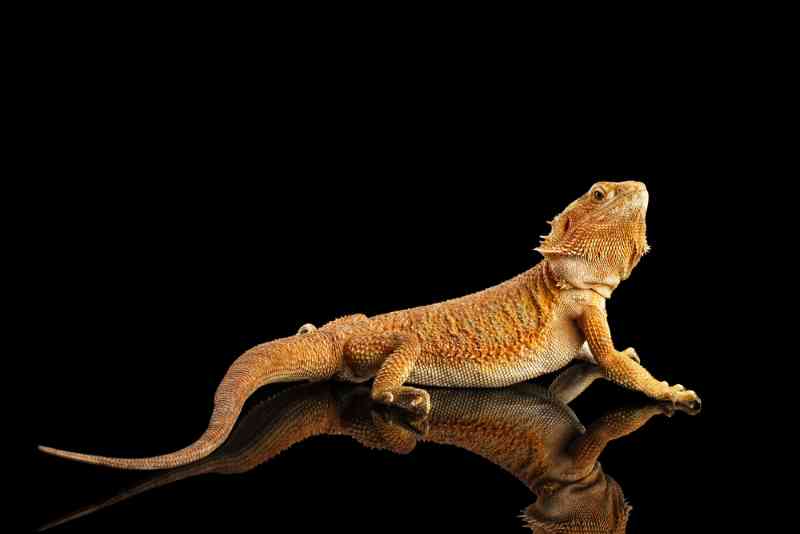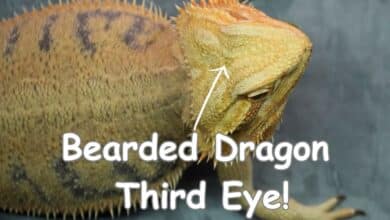Types of Bearded Dragon Tail Injuries and How to Care

Several tail injuries can occur in bearded dragons. This can be a source of anxiety for its owners since, unlike other lizards, bearded dragons cannot regrow their tails.
Bearded dragon tail injuries can be significant or minor occurrences that result in a wide range of outcomes. For example, a bearded dragon can break its tail as well as suffer a variety of illnesses that damage the bone structure in its tail. Metabolic bone disease and tail rot are two of these illnesses.
Continue reading to learn more about different types of bearded dragon tail injuries, what to do if you think your bearded dragon’s tail is broken, the most common reasons why your bearded dragon’s tail appears bent, and more.
Contents
What Are Some Types of Bearded Dragon Tail Injuries?
Bearded dragons can develop a wide range of tail injuries throughout their lives. These can include both major and minor events with a variety of outcomes. For example, bearded dragons can not only break their tails but also develop a form of tail rot which can cause the injured part of your lizard’s tail to rot, die, and eventually fall off the lizard.
Here is a list of common bearded dragon tail injuries:
- Tail Rot: A bacterial infection that can occur when the tail is injured or damaged.
- Tail Tip Necrosis: The death of tissue at the end of the tail, which can be caused by injury or poor circulation.
- Fractured Tail: A break or fracture in the tailbone, which can happen if the tail is pulled or bent too hard.
- Nerve Damage: Damage to the nerves in the tail, which can cause paralysis or loss of function.
- Hemipenal Prolapse: A condition where the male bearded dragon’s reproductive organs protrude from the base of the tail.
- Tail Bite: If two or more bearded dragons are living in the same age, they may fight or simply mistake another bearded dragon’s tail for food and bite their tail.
- Tail Amputation: In some cases, if the tail is severely injured or diseased, amputation may be necessary to prevent further harm.
What Should Owners Do If Their Bearded Dragon Has a Broken Tail?
Clean the Injury
If your lizard has an open wound, you should treat it first to reduce the danger of infection, just like you would with any other type of injury. For example, if your bearded dragon breaks their tail and the wounded section falls off, this can occasionally leave an exposed wound. If this occurs, owners can use a reptile-safe antiseptic solution to treat and clean this open wound.
Owners should, however, consult their veterinarian first to confirm that their bearded dragon has not had any past sensitivities to antiseptics. Your local reptile vet can also provide other medications to help your beardie recover faster.
Splint The Injury
In the case of a tail fracture, an external splint, sling, or cast can be used to keep the tail immobilized until it heals. However, keep in mind that this splint will only help in the case of mild fractures. This splint should also be adjusted every week for approximately the next 4 to 6 weeks, or until the tail has healed completely.
As long as your bearded dragon’s activity is limited, this splinting strategy is typically highly effective. External coaptation treatment, commonly known as external coaptation, is also more successful for fractures caused by bone demineralization. Cage rest is also recommended during this time.
Time To Visit Your Local Veterinarian
If your bearded dragon’s tail is injured and you’re not sure what to do next to help them heal, it’s time to take them to the vet. The vet can not only assist you in determining the exact source of damage, but they can also advise you on the best care treatment plan for your unique bearded dragon.
Why Is My Bearded Dragons Tail Bent?
Metabolic Bone Disease (MBD)
Metabolic bone disease occurs when your bearded dragon’s bones become soft and weak owing to a calcium deficiency. Unfortunately, this can cause your bearded dragon’s tail to bend.
If your bearded dragon has MBF, its bones will become fragile and easily brake as a result of the absence of calcium, while the muscles lose their capacity to contract. This is why metabolic bone disease frequently leads to limb paralysis.
Tail Biting
Your bearded dragon’s tail can bend as a result of tail-biting. When a bearded dragon bites and nibbles on its tail, it is known as tail-biting. This can occur for a wide range of reasons, including boredom, tension, and violence. A Bearded dragon will also start biting their tail if they don’t receive enough of the proper nutrients in its diet.
If you notice your bearded dragon eating its tail, take it to the veterinarian right away for treatment. After all, the sooner you address the tail biting, the less damage your bearded dragon will be able to inflict upon itself.
What Do I Do If Your Bearded Dragon Has a Cut on Their Tail?
Injuries to the tail of a bearded dragon are rarely deadly. As a result, the great majority of them may be cared for at home! For example, Bearded dragon tail injuries can normally be treated with repeated soaks and an antiseptic ointment to prevent infection from spreading.
However, take note that the damaged piece of the tail will most likely fall off over time with little to no injury to the Bearded dragon.
What is Bearded Dragon Tail Rot?
Tail rot is a condition in which bearded dragon tissue begins to die or rot, generally near the tip of the tail. This injured area will also take on a darkish color. It’s a common illness in reptiles that can be difficult to spot in the early stages but can quickly escalate into something lethal if left untreated.
Tail rot mostly affects bearded dragons’ tails, although it can also harm their toes. Due to a lack of blood flow, the tail, or toes, will progressively turn black and become dry and brittle. It’s also possible that the tail has lost all feeling. This is dying tissue, and if left treated, the infection will spread up the tail and to the rest of the body.
What Are the Signs of Bearded Dragon Tail Rot?
Your bearded dragon’s tail will seem dark, rotting, and dried out if it develops tail rot. Tail rot usually begins at the tip of the tail and progresses upward. Tail rot should also not be confused with bearded dragons that have a naturally dark tail, which is rather common and perfectly normal. A naturally black tail will not seem dried out or decaying.
While these are some of the physical identifiers, you should carefully study your lizard to be able to recognize the initial indications of tail rot in order to have the problem treated by a veterinarian and avoid amputation of the tail.
Can You Treat Tail Rot at Home or Should You Take Your Bearded Dragon to the Vet?
Naturally, your bearded dragon’s tail rot should be addressed as quickly as possible by contacting a veterinarian. If found early enough, a veterinarian can treat your beardie with antibiotics and other treatments to save its tail and enhance its general health.
However, if you’re treating your bearded dragon at home, you can follow these simple instructions after consulting with your veterinarian:
1. To keep your bearded dragon’s tail clean, wash it in lukewarm water every day.
2. Soak the tail of your bearded dragon, not the body, in warm water and betadine solution for 5 minutes every day.
3. Using a cotton swab, wipe the afflicted region dry and apply Neosporin.
4. Continue this treatment for a few days while keeping an eye on the tail to make sure the rot isn’t spreading to the rest of the body.
Final Thoughts
Throughout their life, bearded dragons can suffer from a variety of tail injuries. These can be significant or minor occurrences that can result in a wide range of outcomes. Bearded dragons, for example, can break their tails and develop a type of tail rot, which causes the wounded segment of the lizard’s tail to rot, die, and finally fall off.
If an injury occurs, owners should treat and clean the wound using a reptile-safe antiseptic solution and contact their local veterinarian for assistance immediately.
If your bearded dragon’s tail is injured and you’re not sure what to do to help them heal, take them to the vet. The vet can not only help you determine the specific source of the injury, but they can also advise you on the best care treatment plan for your pet.





